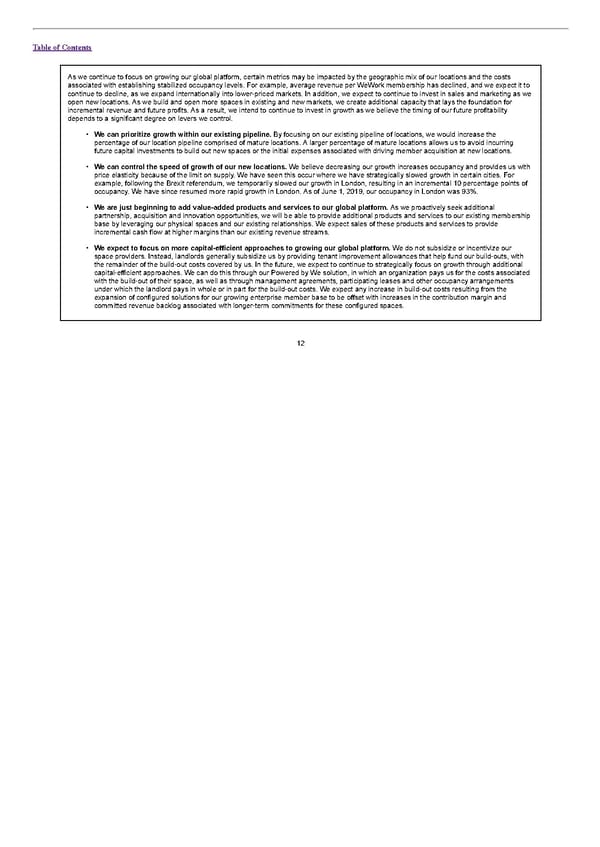Table of Contents As we continue to focus on growing our global platform, certain metrics may be impacted by the geographic mix of our locations and the costs associated with establishing stabilized occupancy levels. For example, average revenue per WeWork membership has declined, and we expect it to continue to decline, as we expand internationally into lower-priced markets. In addition, we expect to continue to invest in sales and marketing as we open new locations. As we build and open more spaces in existing and new markets, we create additional capacity that lays the foundation for incremental revenue and future profits. As a result, we intend to continue to invest in growth as we believe the timing of our future profitability depends to a significant degree on levers we control. • We can prioritize growth within our existing pipeline. By focusing on our existing pipeline of locations, we would increase the percentage of our location pipeline comprised of mature locations. A larger percentage of mature locations allows us to avoid incurring future capital investments to build out new spaces or the initial expenses associated with driving member acquisition at new locations. • We can control the speed of growth of our new locations. We believe decreasing our growth increases occupancy and provides us with price elasticity because of the limit on supply. We have seen this occur where we have strategically slowed growth in certain cities. For example, following the Brexit referendum, we temporarily slowed our growth in London, resulting in an incremental 10 percentage points of occupancy. We have since resumed more rapid growth in London. As of June 1, 2019, our occupancy in London was 93%. • We are just beginning to add value-added products and services to our global platform. As we proactively seek additional partnership, acquisition and innovation opportunities, we will be able to provide additional products and services to our existing membership base by leveraging our physical spaces and our existing relationships. We expect sales of these products and services to provide incremental cash flow at higher margins than our existing revenue streams. • We expect to focus on more capital-efficient approaches to growing our global platform. We do not subsidize or incentivize our space providers. Instead, landlords generally subsidize us by providing tenant improvement allowances that help fund our build-outs, with the remainder of the build-out costs covered by us. In the future, we expect to continue to strategically focus on growth through additional capital-efficient approaches. We can do this through our Powered by We solution, in which an organization pays us for the costs associated with the build-out of their space, as well as through management agreements, participating leases and other occupancy arrangements under which the landlord pays in whole or in part for the build-out costs. We expect any increase in build-out costs resulting from the expansion of configured solutions for our growing enterprise member base to be offset with increases in the contribution margin and committed revenue backlog associated with longer-term commitments for these configured spaces. 12
 S1 - WeWork Prospectus Page 16 Page 18
S1 - WeWork Prospectus Page 16 Page 18